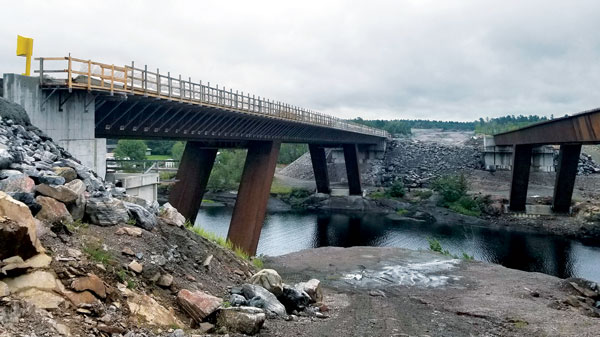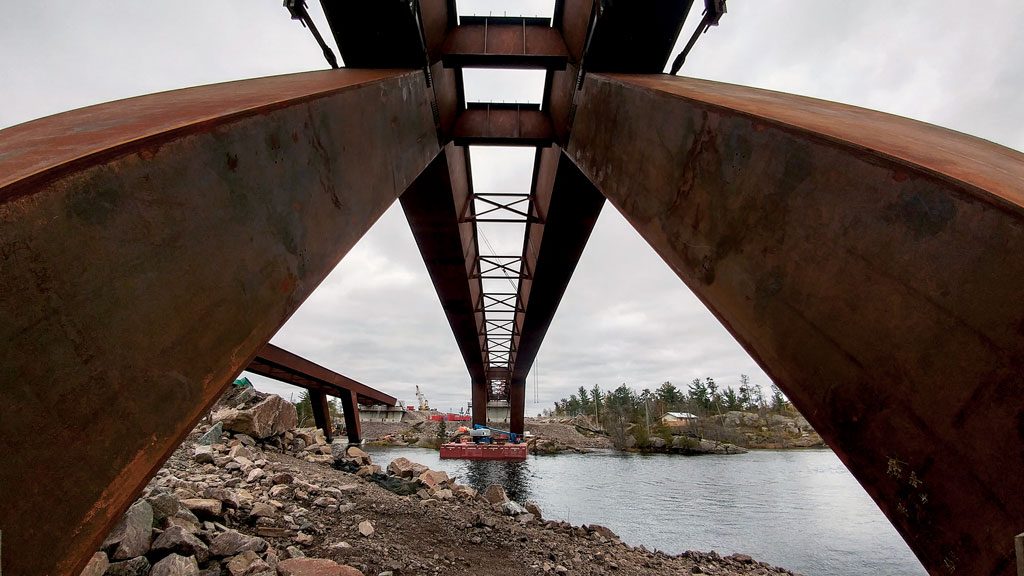Designated as a Canadian heritage river in 1986, the French River and its tributary the Pickerel, are being spanned by four bridges featuring a unique inclined leg girder system designed to keep the structures totally out of the water.
As part of its ongoing expansion of Highway 69 between Parry Sound and Sudbury, the Ministry of Transportation (MTO) is installing the four three-span frame steel box girder bridges over the rivers about 70 kilometres south of Sudbury.
Two bridges (one for the northbound lanes and one for the southbound lanes) cross the French River approximately 2.1 kilometres south of the junction of Highway 607 and Highway 69, while the two Pickerel River structures are about 4.5 kilometres south of that intersection
The general contractor is Bancroft-based J. & P. Leveque Bros. Haulage Ltd. and the design consultant is WSP Canada Group Ltd.
Ranging from 15 to 17 metres (49 to 55 feet) long and weighing about 90,718 kilograms (200,000 pounds) each, the girder legs extend from the shoreline to connect with the main girders which weigh about 99,790 kilograms (220,000) pounds.
“Leg girders have been used in other areas of Ontario, but not of this magnitude,” says MTO area manager Jason Ranger.
They were chosen as the preferred structure type for both crossings based on an assessment of structural characteristics, constructability, long term maintenance, aesthetics, and cost by the ministry and the consultant, he points out.
Steel was selected due to its light weight and easier erection for long-span bridges, which in the case of the southbound French River Bridge is almost 200 metres long (656 feet) and just shy of 139 metres long (456 feet) for the Pickerel River bridges, says Ranger.
Nevertheless, there have been some challenges the ministry, the consultant, and the contractor have had to contend with. They included the logistical ones of delivering the large girder sections to the work areas, the impact of a large forest fire in the Parry Sound area in July 2018, and some poor rock conditions.

“It was primarily on the north shore of the French River,” says contract services administrator Mike Tymeczko, in a reference to those conditions which posed problems in establishing a sound base for the footings.
A specialized team of engineers from the ministry, WSP, David F. Wood Consulting Ltd., and Peto MacCallum Ltd. had to review the site conditions and redesign the footings with rock anchors to add extra support.
“The redesign only took about a month and didn’t impact the schedule,” he says.
Work on the installation of the footings for the Pickerel River bridges was started in October 2017, followed by the French River bridges in June of last year.
A similar sequencing was used in the fabrication which got underway in January 2017 for the Pickerel River bridges and August 2018 for the French River structures. In this project two separate fabricating firms were hired by the contractor to meet the contract schedule.
North Bay-based Central Welding and the Canam Group worked together to complete the work, with Canam assisting by manufacturing six of the girders. Central Welding also built a specially designed transportation trailer to haul the large sections to the bridge sites where they were spliced together and raised into place by a 1,200-tonne crane. The company responsible for installing the girders is Faccia Inc.
The lift for the Pickerel River structures began in April 2018 and May of this year for the French River ones. “Most of the girders were lifted within one to two days.”

All the girders on the Pickerel River bridges are now in place. In mid-September, all of the steel work on the northbound French River bridges was completed. There has been a delay as the crane has had to be diverted to another project, but the target date for completing the steel work on the southbound bridges is Christmas, he says.
Last summer, construction came to a grinding halt for 18 days because of the proximity of the large forest fire in the Parry Sound District. (Known as Parry Sound Fire 33, the forest fire covered 50 square kilometres and forced evacuations of a number of communities.)
“The contractor had to move its workers to other jobs or send them home during that time,” says Tymeczko, noting that the MTO, contract administrator AECOM and the contractor are endeavouring to find ways to make up for the lost time.
Work continues on other bridge sections. By the fall of 2020 the northbound lanes should be open to the public and then the Ministry can begin construction of the southbound lanes, he says.
A total of 10 new bridges are now under various stages of construction in an approximately 14-kilometre stretch from just north of Highway 522 to just north of Highway 607 as part of the ministry’s Contract 2015-5119 for the Highway 69 expansion, he says.




Recent Comments